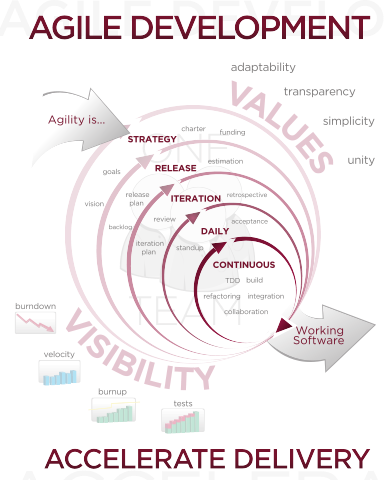CSC/ECE 517 Fall 2012/ch2a 2w5 dp: Difference between revisions
Jump to navigation
Jump to search
No edit summary |
No edit summary |
||
| Line 28: | Line 28: | ||
#Unity | #Unity | ||
[[ | [[File:Agile_poster.png]] | ||
==== Adaptability ==== | ==== Adaptability ==== | ||
==== Transparency ==== | ==== Transparency ==== | ||
Revision as of 02:43, 22 October 2012
Agile Software Development
History
Why Agile?
James Shore and Shane Warden <ref>Shore, James and Warden, Shane. The Art of Agile Development. O’Reilly Media, Inc., 2008, p. 4.</ref> state that the benefit for developers to follow a Agile software development process is to deliver successful products to the client or customer. He defines success into 3 types:
- Organizational
- Deliver value and decrease costs to increase return on investment.
- Technical
- Elegant and maintainable code is produced.
- Personal
- Developers find the project fun and rewarding which lead them to be intrinsically motivated and devote passion to the work.
The Agile Manifesto
The Agile Manifesto <ref>Manifesto for Agile Software Development http://agilemanifesto.org/ </ref> is a set of 12 principles that provide a foundation for agile methodologies.
The core principles of the manifesto are as follows:
- Individuals and interactions over processes and tools
- Working software over comprehensive documentation
- Customer collaboration over contract negotiation
- Responding to change over following a plan
Values
There are four concepts that represent the main values of Agile software development.
- Adaptability
- Transparency
- Simplicity
- Unity
Adaptability
Transparency
Simplicity
Unity
Best Practices
Popular Agile Methods
References
<references />
